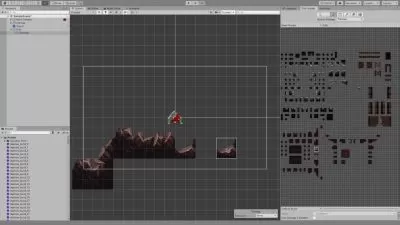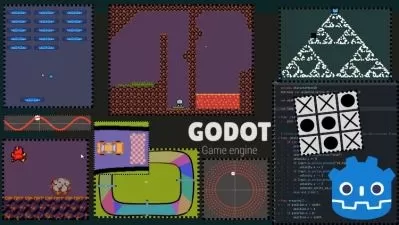Unreal Engine 5: The Intermediate Course
David Nixon
18:57:02
Description
How to Make Video Games Using Materials, Landscapes, Animations & Blueprints in UE5
What You'll Learn?
- Intermediate Unreal Engine 5 concepts used to develop games
- Detailed understanding of Materials and Textures within Unreal Engine to make your graphics pop
- How to create beautiful landscapes and giant open worlds for your games while still achieving high frame rates
- How skeletal meshes work and how to import, edit, assign, control and blend animations
- Intermediate blueprint concepts such as arrays, data tables, spawning, debugging, event dispatchers, and blueprint interfaces
Who is this for?
What You Need to Know?
More details
DescriptionLearn how to make video games with Unreal Engine 5. If you’ve already learned the basics of Unreal Engine and are eager to learn more, this is the course for you. For monetary reasons, almost all courses are beginner’s courses. This course is for those who have been desperately seeking something more advanced on Unreal Engine. Continue your journey towards being a professional video game developer with Unreal Engine 5: The Intermediate Course.
Learn How to Make Video Games with this Unreal Engine 5 Course for Intermediate Game Developers
Continue your game dev studies with one of the most up-to-date Unreal Engine courses available. This course is regularly updated so that it will always cover one of the most recent versions of Unreal Engine 5.
I also spent a great deal of time before the course was first published to plan out all the lessons so that:
nothing is covered without the prerequisite knowledge needed being covered first
lectures and sections are self-contained without jumping from topic to topic
In other words, I strived to structure the course in the “ideal†order, in order to reduce confusion to a minimum. At this point in your studies, you should understand how difficult it is to achieve goals 1 and 2 at the same time, as so many various topics are closely interrelated, so I’m very proud of what I was able to accomplish with this course.
Learn How to Be a Professional Video Game Developer Using Unreal Engine
This course was designed for those who are looking for a professional path of study for Unreal Engine 5. This might not line up with your goals. If you’re just looking to play around a bit, then you may not like the attention to detail. But if you’re interested in getting as good as possible, I’ve designed this course to give you what the others won’t.
This course covers the details that other courses skip, which causes confusion when trying to learn more advanced topics. By the end you should have a thorough understanding of intermediate concepts of Unreal Engine and be fully prepared to move on to more advanced topics.
Intermediate-Level Game Design Concepts
If you are familiar with, at a basic level, concepts such as Projects, Levels, Actors, Meshes, Collisions, and Blueprints, then you are fully prepared to take this course.
The course will cover the following topics in thorough detail:
Materials & Textures
Landscapes & Open Worlds
Skeletal Meshes & Animations
Intermediate Blueprints
Materials and Textures - How to make snazzy, professional-looking materials for your meshes. Includes topics such as material inputs, normal maps, blend modes, shading models, material instances, water materials, material functions, texture masking, UV mapping, texture coordinate node, world position offset, and decals.
Landscapes and Open Worlds - How to make breathtaking landscapes and huge, sprawling open worlds with seamless loading, while still achieving incredible numbers of frames per second. Learn about manage mode, sculpt mode, paint mode, landscape hole materials, landscape auto materials, splines, landscape grass, foliage mode, world partition system, level instances, level of detail (LOD), and nanite.
Skeletal Meshes and Animations - How to animate skeletal meshes in an interactive manner and blend smoothly between animations. Learn about skeletons, sockets, animation sequences, animation blueprints, state machines, blend spaces, cached poses, blend profiles, additive animations, aim offsets, animation montages, notifies, animation curves, morph targets, and animation attributes.
Intermediate Blueprints - Recap the fundamentals of Blueprints, then build upon that knowledge to achieve great skill and flexibility when it comes to scripting your games. Topics include advanced data types, data tables, spawning actors, referencing actors, functions, function libraries, macros, local variables, construction script, debugging, event dispatchers, and blueprint interfaces.
Who this course is for:
- Aspiring game developers who have some basic knowledge of Unreal Engine and wish to continue their studies
- Students with a desire to learn Unreal Engine 5 concepts in great detail
- Those wishing to become professionals using Unreal Engine 5
Learn how to make video games with Unreal Engine 5. If you’ve already learned the basics of Unreal Engine and are eager to learn more, this is the course for you. For monetary reasons, almost all courses are beginner’s courses. This course is for those who have been desperately seeking something more advanced on Unreal Engine. Continue your journey towards being a professional video game developer with Unreal Engine 5: The Intermediate Course.
Learn How to Make Video Games with this Unreal Engine 5 Course for Intermediate Game Developers
Continue your game dev studies with one of the most up-to-date Unreal Engine courses available. This course is regularly updated so that it will always cover one of the most recent versions of Unreal Engine 5.
I also spent a great deal of time before the course was first published to plan out all the lessons so that:
nothing is covered without the prerequisite knowledge needed being covered first
lectures and sections are self-contained without jumping from topic to topic
In other words, I strived to structure the course in the “ideal†order, in order to reduce confusion to a minimum. At this point in your studies, you should understand how difficult it is to achieve goals 1 and 2 at the same time, as so many various topics are closely interrelated, so I’m very proud of what I was able to accomplish with this course.
Learn How to Be a Professional Video Game Developer Using Unreal Engine
This course was designed for those who are looking for a professional path of study for Unreal Engine 5. This might not line up with your goals. If you’re just looking to play around a bit, then you may not like the attention to detail. But if you’re interested in getting as good as possible, I’ve designed this course to give you what the others won’t.
This course covers the details that other courses skip, which causes confusion when trying to learn more advanced topics. By the end you should have a thorough understanding of intermediate concepts of Unreal Engine and be fully prepared to move on to more advanced topics.
Intermediate-Level Game Design Concepts
If you are familiar with, at a basic level, concepts such as Projects, Levels, Actors, Meshes, Collisions, and Blueprints, then you are fully prepared to take this course.
The course will cover the following topics in thorough detail:
Materials & Textures
Landscapes & Open Worlds
Skeletal Meshes & Animations
Intermediate Blueprints
Materials and Textures - How to make snazzy, professional-looking materials for your meshes. Includes topics such as material inputs, normal maps, blend modes, shading models, material instances, water materials, material functions, texture masking, UV mapping, texture coordinate node, world position offset, and decals.
Landscapes and Open Worlds - How to make breathtaking landscapes and huge, sprawling open worlds with seamless loading, while still achieving incredible numbers of frames per second. Learn about manage mode, sculpt mode, paint mode, landscape hole materials, landscape auto materials, splines, landscape grass, foliage mode, world partition system, level instances, level of detail (LOD), and nanite.
Skeletal Meshes and Animations - How to animate skeletal meshes in an interactive manner and blend smoothly between animations. Learn about skeletons, sockets, animation sequences, animation blueprints, state machines, blend spaces, cached poses, blend profiles, additive animations, aim offsets, animation montages, notifies, animation curves, morph targets, and animation attributes.
Intermediate Blueprints - Recap the fundamentals of Blueprints, then build upon that knowledge to achieve great skill and flexibility when it comes to scripting your games. Topics include advanced data types, data tables, spawning actors, referencing actors, functions, function libraries, macros, local variables, construction script, debugging, event dispatchers, and blueprint interfaces.
Who this course is for:
- Aspiring game developers who have some basic knowledge of Unreal Engine and wish to continue their studies
- Students with a desire to learn Unreal Engine 5 concepts in great detail
- Those wishing to become professionals using Unreal Engine 5
User Reviews
Rating
David Nixon
Instructor's Courses
Udemy
View courses Udemy- language english
- Training sessions 100
- duration 18:57:02
- Release Date 2024/04/24














